The following story is dedicated to all the rescuers killed at the World Trade Center Incident, September 11, 2001. This tragedy portrayed the sheer evil hidden in man’s darker side … and, in turn, the heroes who rise above it all. (Note: due to this story being written five months after the event, the accuracy of all facts cannot be fully recalled or determined. There are also periods of time and activities that I simply don’t remember.)
Day: [1] 2 3 4 5 6 7 8 9 10 The Last Day
DAY ONE
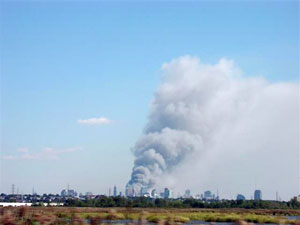
September 11, 2001 — a day etched in our minds and in our history. A day that has undoubtedly changed the way we view our lives and the freedom which we have taken for granted over so many years. A day which shattered our self-confidence and shook our sense of security to its very foundation. Something we always took for granted, I suppose. We’ve never experienced a major attack on the U.S. mainland before. Maybe because we are the mightiest country on earth, we felt that we never would. We always felt that our daily routine would never be compromised. “The great American lifestyle.” We get up in the morning, have our breakfast, read the paper, get the kids off to school, kiss our loved one goodbye and head off to work. Come home from work, eat dinner, watch TV, go to bed, get up in the morning and repeat the process. Except for the weekends. We then could look forward to going out to dinner, maybe a movie on a Friday night, get up Saturday morning and head down to our favorite coffee shop and plan out the day’s tasks whether they be work or pleasure. Stop by the video store on the way home and rent that movie we’ve been waiting to see. Sunday finds us getting out to church or visiting friends and family, calling it an early evening and vegetating in front of the TV or reading a good book, planning the work week ahead in our minds. We get up Monday morning and start the process all over again. It may be routine and even a bit dull in ways, but it’s predictable and we know what to expect. It is normalcy. We have control over our lives and feel secure in that thought. Until September 11th. Then, whether we have accepted it or not yet, our country, our lives and our sense of normalcy were changed forever.
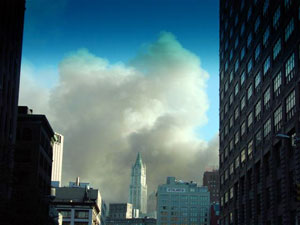
I started my day flying out of town on a typical business trip. To New York, I always fly USAIR because they have non-stop direct service to LaGuardia. I usually arrive around 7:30 AM and make it into the city by 8:30. Any other trip and I would have arrived at my hotel 15 minutes before the first plane attack and, no doubt, would have been downtown within 30 minutes, just after the second strike.
This trip, however, even after buying a ticket on USAIR, I change my plans on Sunday. Instead I book another flight on United through Washington Dulles Airport and come in a day earlier than originally planned — Tuesday, September 11th. Having to now connect, my new itinerary puts me into New York three hours later than usual. So I schedule no meetings until the afternoon and decide to just reissue the USAIR ticket on a future trip. Just a feeling. Something that can’t be explained. After watching Monday Night Football, I switch over to the Weather Channel and notice a major storm front coming through that night, all the way up the eastern seaboard, including New York. It’s supposed to push off the coast by early morning and I feel comfortable with flying the next day. I realize later on, that if the storm would have stalled, the attack would not have happened that day, with poor visibility being a big issue. I drive to the airport and take off on time, arriving in Dulles right on schedule. Yet another uneventful flight. Just the way I like them. I get off the plane and walk into the terminal to check the monitor for my connecting gate. It is around 9:00. The screen reads “cancelled,” as does the flight after that to New York. Everything else shows “on-time,” so I think nothing of it, just another quirky travel day.
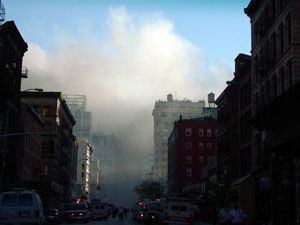
I walk up to the counter and ask what the story is before booking a new flight. The gate agent says “Two planes hit the towers.” She has a very distraught look on her face. The first thought in my mind is an aviation accident at LaGuardia. Two planes must have collided over the airport and fallen on the control tower. That’s why all the other flights weren’t affected. But I could have sworn she said “towers,” as in plural. So I hesitate, then ask her to clarify and she tells me that two airplanes flew into the World Trade Center. I stand there in shock for about five seconds while the magnitude of her statement sinks in. Terrorism. I then ask where my bags will go, as I know two things at that moment. There won’t be any more outbound flights, regardless of what the monitor says and I need to get to New York, right now. I dash down to baggage claim and find my carousel, while talking to the office on my cell phone. I instruct them to buy me a train ticket from D.C. to New York and, oddly enough, they are successful in doing so. After hanging up, it suddenly occurs to me that all train stations, as well as airports, are going to be shut down very soon due to the obvious fact we are under attack from terrorists. I then decide that I am going to have to drive up there, if I can even approach the city by car. Given that Manhattan sits on an island, it is a given that all bridges and tunnels into the city are also going to be shut down, as they are prime targets as well. About that time, the P.A. system announces that the airport is now officially closed and to leave all terminals immediately. Well, that wasn’t a surprise, but I still need my bags. I dash outside to be confronted with a line of about 200 people waiting for cabs.

Holy Moley!! I then “convince” the curb attendant to immediately set aside a cab which can take me all the way to New York. He, of course, thinks I’m nuts. I want to go to a city under terrorist attack. I go back inside and note that the carousel is moving, with my flight number displayed overhead. I wait about three minutes for my bags, then say to heck with it and head back outside. As I’m leaving the terminal, a nearby TV monitor catches my eye. I stop in mid-stride and stare at it, not believing what I am seeing. The twin towers are burning. They look like two birthday candles right after the recipient blows the flame out. Heavy black smoke is pouring from the tops of both buildings. For a few moments, I can’t take my eyes off the screen, transfixed at the sight I am seeing. It’s as if my mind is failing to accept or absorb what I had already been told. An unimaginable tragedy is unfolding right there on live national TV. It is finally then that it hits me that those planes were not small propeller planes, as I had thought. Looking at the damage and number of fire floors, I know that they had to be jetliners … with a lot of fuel on board.
Hijacked, no doubt. I thought hijacking was a thing of the past in this country! Everyone on the planes and points of impact within the towers are surely dead. The death toll must be catastrophic and I am stunned by it. This has to be some kind of bad dream. I snap out of my momentary trance, rush out to the curb and hop in the cab, knowing that it is going to be a very long and challenging ride, with heavy traffic, I’m certain. I urge the driver to go as fast as possible, that I’ll take care of talking to the police if we get pulled. It will take about five hours or so to get there. Clearing the airport, I call the office and am told that the Pentagon has also just been hit. I turn to look back over my shoulder and see a huge column of smoke in the near distance, barely 10-15 miles away or so. God, I’m in a city under attack, trying to get to another city under attack. I pause and wonder if what I am doing really makes any sense at all. Should I still head to New York or turn around and head towards the Pentagon, which is the closest event? What will I do when … or even if … I can get to either site? Can I do anything that will make a difference?
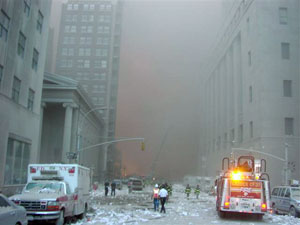
Even though New York is much further away, I feel there is where the greatest tragedy lies, where the most help is needed and where our pre-plans and knowledge can do the most good. Although we have no data on the WTC, we do have plans for buildings that surround the complex and are most likely to be affected as well, by falling debris. We continue on in all due haste to New York. I feel confident that if I can just get there, I should be able to offer enough assistance to the FDNY to at least make my presence justifiable. I decide to call Bob Drennan, a close friend and retired Battalion Chief from Philadelphia. We talk briefly about the two disasters and then he tells me the towers have fallen. I almost drop the cell phone. It hits me like a sledge hammer. Two 110-story buildings are no longer standing. We discuss the possible death toll and agree it is high. We both realize that there has to be a huge loss of firefighters and talk of it only for a few seconds. It is a topic that neither of us wants to contemplate. I wonder to myself how many of them I knew. Then he tells me that another Philly chief, Tom Garrity is in New York, working on an assignment for us. The pit in my stomach grows. The office didn’t even mention it to me. Knowing Tom, he’s somewhere in the thick of things, if he’s even alive. I’ve seen both these guys on the job, riding with them years ago when I visited their city on business. They are extremely talented, aggressive and tough as nails under pressure. Bob suggests that the office try and reach Tom, verify he’s OK, then notify his fiancée of his status. Before we hang-up though, I throw out the idea of chemical/biological weapons on the plane in the form of checked baggage. Bob agrees that it is a distinct possibility. It seems logical that if these terrorists are crazy enough to fly airliners into the World Trade Center, then it shouldn’t be unthinkable that NBC warfare may also be involved. It is obvious that their goal is to kill a very large number of people.
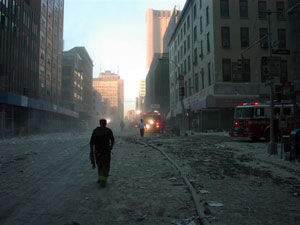
I decide to place a call directly into the NYC dispatch center and suggest they relay a message on to the command post of the additional threat. They agree that it has definite merit and promise to do so. I figure with everything that has happened and is continuing to unfold, maybe the issue hasn’t been raised yet. Then I have the office check on Tom’s status and if he’s still alive, to contact me when I get to the city. He would probably be more valuable to the command post than I would be, given his experience in commanding high-rise fires. Hours pass agonizingly slow as we continue to make our way along towards New York. Approaching from New Jersey, you can begin to see a feint, dark haze floating across the horizon towards the south. We are still an hour and maybe 50 miles away. I tell the cabbie that the barely noticeable haze is smoke from a very big fire. He glances at me in the mirror with a worried look on his face.
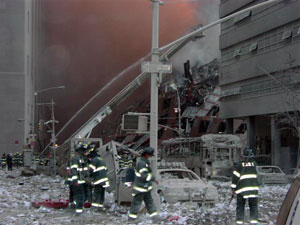
He says to me with a great sense of pride that he will do whatever it takes to help me and serve his country in this time of need. Ironically enough, he is of middle-eastern descent and comes across as being a nice, amiable person. As we get closer to the city, the slight haze becomes a monstrous plume of brown and black smoke. More smoke than I’ve ever seen. It appears to me as a huge F-5 tornado turned sideways. It stands in vivid, stark contrast against a cloudless, powder-blue sky. I wonder how such a terrible catastrophe can occur on such a perfect, sunny day. I look up and see signs saying “New Jersey Turnpike closed — all roads to New York closed.” I ask him to stop at the police car guarding the highway barrier where traffic is being funneled off onto secondary roadways. I tell the officer that I have to get to the site; the firefighters are going to need all the help they can get. He simply says “Go” and moves his car to let us through. We fly along, the only vehicle on the road. It seems strange, having the New Jersey Turnpike all to ourselves on a weekday. We pass through several more checkpoints. The scrutiny of each stop gets tighter and tighter as we near the Hudson River. I have to repeatedly explain my intentions, but certainly understand why. We are under attack. These guys are protecting New York from afar, making sure no one gets through without a very good reason. Somehow, I get all the way to the New York & New Jersey Port Authority Police command post near the entrance to the Lincoln Tunnel. I let my cab driver go and he ends up with the biggest fare of his life — $600. I bump into the chief engineer from the World Trade Center, run by the Port Authority and just leased for $3.5 billion, to a private real estate firm only three weeks before the disaster.

It is obvious by his disheveled look that he has been at the site. I immediately ask if Alan Reiss, the Director of the World Trade Center and a friend whom I have come to know and admire over the past few years, is safe. His office is on the 88th floor of Tower One. I am told he was in the building, but he got out alive. The engineer jots down two phone numbers, including Alan’s home number for me to get in touch with him. He is obviously rattled, as his hands shake uncontrollably. As he finishes writing down the numbers, I look over towards New York and the horrendous column of smoke emanating from what quickly becomes known as “Ground Zero.” It obscures all of lower Manhattan. Although I know I’m going to do whatever it takes to get over there, I wonder if that is really such a good thing. I realize what awaits me and feel a brief moment of uncertainty as to whether I really need to see and experience it all, just to try and pitch in. I’m only one person and I know that doesn’t count for much. I accept the fact that I’ll probably never be the same if I go, but I go anyway. I ask for help in getting across the river and the Port Authority officials graciously agree to run me through the tunnel, even though it is officially closed to all traffic. Similar to being on the NJ Turnpike, it seems so odd to be flying along inside the Lincoln Tunnel, all by ourselves. The driver lets me off on the other side at another security check point and I hail a cab to get to my hotel.
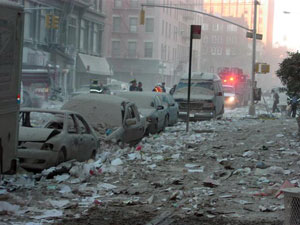
Although my bags are back in Dulles, I have to get rid of my briefcase and camera. I never travel with a camera, but brought one with me this trip due to my desire to add a few interior shots of high-rise building features to my PowerPoint presentation on the topic. It ends up being very valuable today. I drop my things off and dash over to a nearby police precinct to get a ride to the site. I recall thinking that there is probably only one fire department in the world that can handle an incident this big and it is the FDNY. I’m downtown in 15 minutes. If Hell exists, then this must be it. I experience sights, smells and sounds that can’t be properly conveyed to people who weren’t there. It’s just impossible to put things into context. Unimaginable. Unexplainable. Unbelievable. I look around and realize that things will indeed never be the same for me or any other American. This is the largest attack in history on the U.S. I assume the life loss must be staggering.
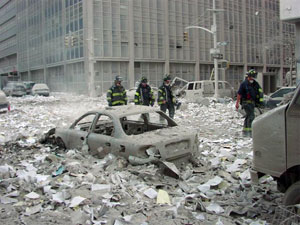
I know there are a lot of dead and injured firefighters. Admittedly, that thought disturbs me more than anything else. The smoke and dust is so thick you can barely breathe. Coughing becomes the routine for the day. It is snowing, but it is not snow. A blizzard of white ash rains down from every angle. You can’t get away from it … or the smoke. It has an acidic, harsh taste and leaves a burning sensation in both the eyes and the throat. It is eerily quiet. None of the typical New York noises — constant blasting of horns, bumper-to-bumper traffic, people crammed onto sidewalks, nudging into one another, yakking away on cell phones. A city where everyone is almost nose to nose, yet at the same time in their own little world. Everything is so hauntingly still, so silent. Death marches nearby. You can feel it. Oddly, I find it reminiscent of the movie “The Day After” … except this was “the day of.” This is what nuclear winter must be like. I see the smoke briefly change from dense black and brown to red and orange, boiling up from the site. I know this is not a good place to be. I pause and think of how ludicrous it is to be standing there in dress clothes — no turnout gear, anything. I figure everything that is bad must be in this smoke I’m sucking in, but no one, not even the firefighters that pass by are protecting themselves. Plenty of tanks on backs, yet nobody with a mask on.
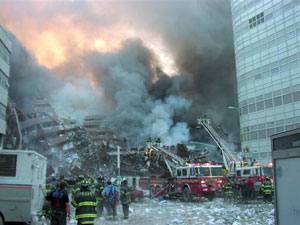
It’s not feasible to wear one and everyone knows it. It would be too cumbersome and refilling air cylinders would be almost impossible to do. They’ve just got to deal with it and move on with the tasks at hand, which are many and daunting. Streets that I’ve walked down a million times are unrecognizable. There were several times where I stopped, looked around and had no idea where I was. The streets all looked the same, grey/white and ashen. I remember how I used to look to the twin towers at times when I needed to get my bearings walking downtown and they were in sight. They weren’t just landmarks; they were beacons, both day and night. Pillars of strength. Monuments to our economic prosperity and might. They were indeed marvels of engineering. Even though I know they’re gone, I still find myself instinctively looking for them, somehow hoping they will appear through the smoke and offer assurance once again that everything is OK … “We’re over here in case you’re lost.” My mind races back to the ‘93 bombing. It was a cold, blustery winter day here in New York, with light snow flurries falling from a dark, brooding sky. It is eerily similar to today, except the “snow” falling is dust and small shreds of paper from the towers themselves, not the warm, blue sky above. I explicitly remember having lunch that day with the property manager of the John Hancock Center in Chicago, another 100-story building we had just finished pre-planning.
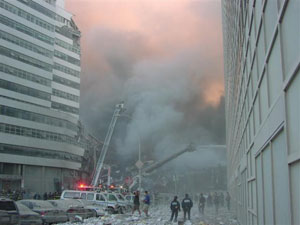
We sat there in the restaurant with his boss on Michigan Avenue when Dean Johnson’s phone rang with the news that the World Trade Center had just been bombed. We raced back to his building just in time to field a barrage of reporters wanting to know what their level of preparedness was. I helped with the media, then left to do four television and two more newspaper interviews before the day was through. Here I was in Chicago and I desperately wanted to be in New York, trying to offer some help, instead of talking to a camera. Then the call comes into our home office that the Port Authority had contacted us and wanted to know if I could come up to the city as soon as possible. Since it was a Friday and things didn’t look all that bad, I told them I’d be up there Monday morning after returning home and repacking over the weekend. I was at the complex by 9:30 Monday and was given the grand tour of the crater, two levels below grade. There was a very low fatality count, but thousands were injured. The devastation was breathtaking. I remember standing next to this huge hole several floors deep, pipes and wires hanging everywhere. There were still the shells nearby of several gutted automobiles. It was obvious that this was a major explosion.
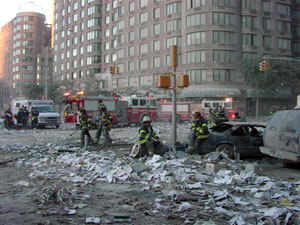
As I stood there kicking myself for not bringing a camera, I couldn’t help but think what might have happened if the bomb had gone off directly below Tower One, instead of between the tower and the hotel. The thought of one of the towers toppling was truly mind-boggling, I will admit, yet it was the first time the possibility had entered my mind. I remember being interviewed by two or three national publications within the week to follow. They told me that all the architectural, structural and engineering experts they talked to agreed that the towers could not be brought down by a bomb. I clearly recall them all saying that a plane flying into one of the towers wouldn’t even bring it down. They had said they built the buildings with that scenario in mind. I remember being the lone voice adamantly disagreeing with their opinion, feeling that regardless as to whether a plane could or could not knock a tower over on impact, the release and ignition of the jet fuel would undoubtedly be enough to compromise the structural integrity of the tower in question. To me, common sense dictated that the fuel-fed fire would easily exceed 2,000 degrees. Fireproofing would be scraped off. Sprinklers would be destroyed. With the failure temperature of steel being around 1,100 degrees and with the compressive load being generated on the fire floors from the remaining stories above, the collapse of the tower would be a given.
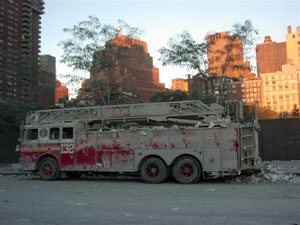
Along with everyone else, I figured that an aviation accident, much less a terrorist attack, of that magnitude was still an unthinkable scenario. The collapse of even one of the massive towers was a thought that I admittedly could not easily entertain. Yet, standing there with a commanding view of the crater that February day over eight years ago, made me think whether we actually take a threat of that nature seriously enough. It is evident that someone has an agenda against us, but were they really attempting to bring one or both of the buildings down? Were they really trying to kill tens of thousands of innocent civilians and strike a blow at the very heart of America and all that we believe in? My mind snaps back to this warm September day, not 100 feet from where the bomb in 1993 detonated. Did they, in fact, succeed in bringing them down this time? It just can’t be true, can it? The reality of it all grips me when the wind shifts again, the smoke momentarily clears and I find myself standing motionless on Liberty Street, staring in disbelief at the spot where the two mighty towers once stood. The towers are gone … it’s almost too much for my mind to accept.

I find myself wishing this was some kind of terrible dream, yet I know it’s all too real. I glance down to the corner of West and Liberty and see an old 30-story building heavily involved in fire, damn near from top to bottom. I look over my shoulder at One Liberty Plaza. A good friend of mine, Larry Graham, works in that building. He oversees it and all the other assets in the U.S. for one of the largest real estate companies in North America. His office is on the 6th floor, facing the Trade Center. My stomach feels twisted as I wonder if he made it out of here alive. His building must be missing a hundred windows, but you can tell it is structurally sound. It was the original headquarters of U.S. Steel and it is an incredibly sturdy 53-story tower. There is no way to tell who’s alive and who’s not at this point. I hope he was in midtown this morning and he’s alright, along with Nancy, his wonderfully warm and caring assistant. Suddenly, to my right, something odd catches my attention through the dense smoke. It looks like pieces of steel sticking out the side of the Bankers Trust Building at 130 Liberty Street. I walk closer and stare upwards. Seemingly as if a giant cat has slashed the front of the building with its claw, a huge gaping hole about 20 feet across exists from around the 25th floor all the way down to about the 10th floor. The curtain wall, floor slabs, everything — gone. Just open space where offices once were and several large steel columns protruding out of the middle of the gash. You could tell that they didn’t belong to the building. One of the towers must have fallen over and struck it, I thought. It was an imposing sight.
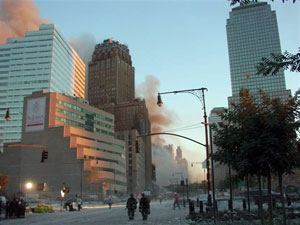
I work my way over to the World Financial Center and see hundreds of windows missing, the renowned and beautiful Wintergarden badly damaged, the facades of skyscrapers scoured, with one 50-story building apparently also being struck by one of the falling twin towers. Similar to 130 Liberty, several large steel columns jut out from the corner offices up around the 20th floor. It confirms my belief that the towers did not collapse straight down into one large debris pile. At last, I turn my attention to where the World Trade Center once stood. The bizarre scene is displayed before me. All that is left is a large mass of burning, smoking debris, yet surprisingly, only a few stories tall. I’m guessing 50 feet high or so. This is where two 110-story buildings were just a few short hours ago? The thought of countless visits to the complex … the mall, meetings with the Port Authority, hooking up with Alan for lunch or breakfast. Alan Reiss is an individual who is the exact opposite of what you might perceive a man in his position to be.
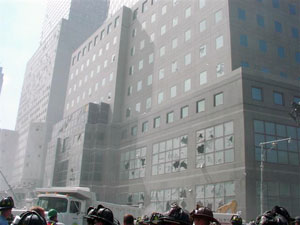
You would think someone who is in charge of all the day-to-day operations of the world’s largest office complex and responsible for the lives of over 100,000 people a day to be unapproachable, self-centered, aloof. No, Alan is one of the kindest, respectful, most warmhearted, easy-going people you could ever hope to meet. That’s why I’ve always gravitated towards folks like him and Larry. They’re just simply “good people,” which makes me wonder why someone would want to try and kill them and so many more innocent civilians. It just doesn’t make sense. As I stand there staring intently straight through the smoky air towards where the imposing twin towers once soared, my mind momentarily wanders back to a breakfast Alan and I had one day last year. He surprised me by taking me up to the “Windows on the World” restaurant at the top of Tower One. He thought I might like the view while we ate. Unfortunately, when we got up there and were seated, low-lying clouds moved in below us, obscuring our view of the busy city below. A city slowly coming to life as another workday began for everyone. It didn’t matter though, as we had a great time talking up a storm anyway. I could have sat there for hours listening to Alan tell me of the latest adventures at the complex. This man’s pretty much seen it all, yet I know he wasn’t prepared for what happened today, September 11. No one could be. How many people came to work today here at the Trade Center that could have possibly envisioned in their worst nightmares what was going to occur as they poured that first cup of hot coffee and opened their morning e-mails?
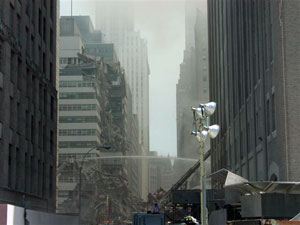
Looking out over the city for a few moments before beginning the day from their offices high up in two of the tallest buildings in the world, just as I did a few months before. Minutes later they’re diving out that very same window to certain death below, some hand-in-hand with their co-workers. Plenty of time to ponder the horror of their actions on the way down from 1,000 feet up. As I stare up into the sky to where the restaurant once was, I pause to consider if I had taken my regular flight and dined with Alan on this morning up on the 107th floor, what I might do if I were in the same position these people were? … Staring at certain death, with no way out — up or down … elevators and stairwells destroyed … fire everywhere … I have difficulty contemplating the thought … and what my decision might be. After all, I’m a survivor by nature. My training and experience as a former firefighter would tell me not to give up, never give in to fire, find a way out and lead others to safety. But what if there is no way out and you feel the building shifting and you know there is no chance of the fire department extinguishing this much fire, this high up before imminent structural failure occurs … the fire is working its way towards you and time is running out. You will not accept the fate of burning to death … no firefighter would. You are confronted with a sense of finality. The decision settling into my mind disturbs me, yet I realize that it is the logical and correct one.
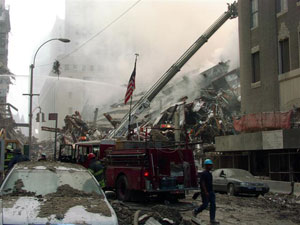
The fleeting thought quickly dissolves and I am still standing there fixated on the pile of rubble where the towers used to be … and the innocent people who had once occupied them. It is so very hard to fathom what it must have been like, for the civilians and firefighters alike, before and just after the buildings came crashing down around them. I do not wish to stare anymore at where thousands have died only hours ago. I look around me, expecting to see tons of glass and furniture everywhere and can find none. How did 220 floors of furnishings just disappear? Was it vaporized by the weight of the collapsing structures? I discover later that I’m not the first person to note this strange phenomenon. I continue circling the site, “sizing up” the scope of the disaster. It is truly beyond comprehension. Two buildings disappear, many more badly damaged and it suddenly occurs to me that we are instantly at war. A war with an unseen enemy and possibly with no end. Things are clearly going to get ugly between us and them and this may not be the worst of it. That thought alone disturbs me. This isn’t the way I envisioned the first day of my business trip turning out.
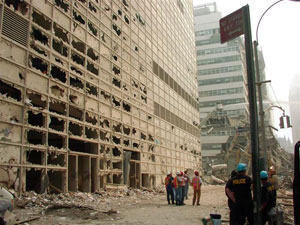
In between sticking my head into lobbies and checking for people as I continue making my way around the area, I wonder if all the surrounding buildings have been searched yet. I know a lot of firefighters are missing and I’m curious if enough personnel exist to accomplish all that has to be done — search and rescue on the debris pile, searching exposures, suppressing fires both in nearby buildings and at the collapse zone, in addition to countless car fires. How are stations being backfilled? How is the city responding to other emergencies throughout the city? How do you deal with something this big? The drain on resources must be tremendous. They probably need all the help they can get. I am a civilian trying to be a firefighter again. Trying to do what feels natural and instinctive from years of performing the same basic functions. This time, however, I was on my own and not really sure what I could do to help make a difference. I’ve never felt so insignificant in all my life. I come across dazed firefighters coated with dust, ask which buildings have been searched and am told “I don’t know.” I ask where the command post is and am told there are several. I am also informed that the initial command post was wiped out, along with all the chiefs. I look into face, after face, after face and see the same expression. Some might call it shock, I refer to it as the “million mile stare.” I could relate a bit, as I would do something productive for a minute or two, then stop and just completely lose my train of thought. I couldn’t figure out what I needed to do next and what might have already been done … or if I even belonged there. I felt naked without any gear. I honestly admit there were a few moments where I felt completely overwhelmed by the sheer magnitude of the event. The human mind sometimes simply shuts down momentarily, due to input overload.

This was on a scale like nothing I’d ever seen. It just seemed too much to be real. Everyone was feeling it. Except for the chiefs. At least they didn’t show it anyway. I round a corner northeast of the site and find a deputy chief surrounded by about 50 firefighters. I didn’t recognize him, figuring he must be from another borough of the city (I believe it turned out to be Chief Pat McNally from Queens). His gear and face are covered in soot and ash. It continues to rain down on everyone. The men need a leader and they need assignments in this crisis. This is when true leaders lead. He stands there like a rock and just starts ripping off orders to his men. I’ve never seen such effective and decisive leadership under intense pressure … ever. And that includes 20 years in the fire service, paid and volunteer. I stood there in awe and watched this chief command his troops in a way that re-instilled confidence and assurance that the worst was over but a great deal of work still had to be done. And they were going to do it. I approach and speak with him briefly, advising that most of the buildings surrounding the Trade Center have pre-plans in them for fire department use.

I also bring up the issue regarding the possible presence of biological/chemical weapons on board in checked bags, prior to the planes hitting the towers. He agrees to the threat, but obviously he has enough to deal with for the moment. I wish him and his men to be safe, deciding to work my way around the scene some more. We shake hands and I dissolve back into the crowd. There is so much activity going on around me. I try and determine if other nearby buildings have been searched and cleared, looking for walking wounded to herd towards nearby medical facilities. The smoke is like nothing I’ve ever seen. It’s so thick, so choking thick. And you could tell by the smell, there was some nasty stuff burning in the fires. My eyes are burning like hell and I keep coughing uncontrollably. I look around me in disbelief. Surrounding structures are free burning. High-rise buildings with fire blowing out window after window. This isn’t New York, its Beirut. It’s a war zone. I walk by fire trucks crushed beyond recognition, cars with all the glass missing, paint stripped completely off the metal bodies. Rims with tires burned off. I see one car in the middle of the street with the hood up and the engine missing. Gone. Where? Gone where? Store fronts blown in as if they were hit by a tsunami of wind and debris. Fire escapes 20 stories high loaded with material from the towers. The streets are submerged in trash, coated with dust, a foot or more thick in some places. When the wind shifts again and the smoke momentarily clears — there they were — cars and trucks as far as you could see completely demolished. Some herded into groups, huddled together right in the roadway … or up on the sidewalks against buildings. All the glass blown out, but none in the street. I look inside a few cars and don’t see any either. Where’s the glass? As I mentioned, other things I see won’t be discussed.

It’s certainly a tragedy of epic proportions. I have a hard time absorbing it all. There’s just so much destruction … everywhere. The scene is truly surreal. I work my way around the area, helping out wherever I can, until I come across the forward fire department command post at Broadway, Park Row, and Vesey (or N.E. sector). Chief Frank Fellini is the incident commander, but we haven’t met before. He is running the show as if it were just another routine “room and contents” house fire. Courage under fire. Even in the face of incredible danger … adjacent buildings on the verge of collapse, fire, smoke and mayhem everywhere … and, I’m sure, the thought that there are many firefighters missing in the streets and in the rubble. Co-workers. Friends. Too many to count. It has to be eating at him, I think. He is unwavering. There is an almost insurmountable task facing him. Both the city and its fire department, indeed, even the nation, has been brought to its knees. Yet, this chief will ensure that his men will meet the challenge, as they always have … as they always will. He is commanding the worst man-made catastrophe in our country’s history … and the worst loss of life ever to strike the American fire service. Under his command, the incident will be stabilized and order will be restored amidst all this chaos. Control and reason will be wrested from all this insanity. He will somehow make sense of a senseless tragedy. When I first approach him after a brief introduction, the first words out of me are “Chief, what are we looking at, about 20,000?” (as in fatalities) … He stares at the site briefly, then turns to look at me eye to eye and replies with a hollow resonance, “Yeah, about 20,000.” I believe at that moment in time, we are both shocked at what was just said. Almost too afraid to ask, I inquire, “How many firefighters are missing?” “Around 250 men,” he says. I think to myself, “What is the previous high, 14 out in Colorado?” … Numbness overcomes me and for a few seconds I can’t think of anything to say. I then introduce myself to Chief Fellini’s Operations Chief, Tom Haring and we talk briefly about matters at hand. Knowing 7 World Trade Center is on the verge of collapse, he has already established a collapse zone and has removed all personnel from harm’s away. The chief is very poised and seems to be getting a good handle on things. As he talks to me with a quiet confidence, the radio crackles with one transmission after another.
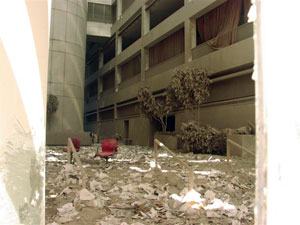
He addresses each one quickly and effectively. We discuss the hazardous materials aspects of the incident as we each realize this is not just a terrorist attack and resultant collapse of two tall buildings. There was a significant amount of toxic substances in the towers and it is a given that a fair amount of them had to be released by the compression of the buildings coming down, as well as the fire and smoke now spewing from the rubble. I offer to put together a list of what I believe may be involved for his review. He agrees, as this is a growing concern on his mind, in addition to everything else he is dealing with. Search and rescue is still the obvious priority. Chief Fellini leaves to go talk with other chiefs at the scene. I stop for a moment and start running people that I have come to know in the FDNY through my head, hoping they’re not among the missing. I know that the downtown area is under the command of Division Chief Pete Hayden and he would be working this week, as I just talked to him yesterday. We would be meeting on Friday. Not now. I just hope we can reschedule. Meaning that he is alive. He is a fine man and an excellent fire chief, as good as they come. I hope he’s OK. One of the guys at the command post mentions to me that there is still one aircraft that has not been accounted for and they are concerned that we could still take another hit. It’s enough to raise the hair on the back of your neck, believe me.
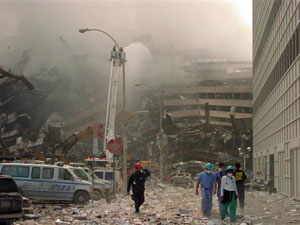
At that point, we couldn’t sustain another strike. It turns out that the plane that goes down outside Pittsburgh is the one that’s missing and the only one that didn’t succeed in hitting a key target. It had actually been accounted for hours earlier. Within minutes, I notice the sound of a jet overhead. I don’t worry for a second though. Before I even look up, I note the unmistakable sound of a fighter plane and relief washes over me as I know that the skies above us are now safe and secure. The boys have our backs. It is odd though, listening to the roar of fighter jets circling Manhattan, instead of the familiar sound of airliners approaching and departing one of the three major airports nearby. I discover later that the Navy is positioning an aircraft carrier off the coast to protect the city’s airspace, eliminating any further danger from above. After a little more conversation, I leave the pre-plan for World Financial Center Tower A with the chief’s aid and disappear to find us some water, as we are all getting a little dehydrated. It is in the upper 70s and warmer standing on the pavement. As I’m wandering around, I hear a loud roar around 5:00 or so. I don’t see anything except a large dust cloud heading in my direction. Ducking into a store entrance, the cloud passes fairly quickly as the wind seems to be picking up. I am later told that it was 7 World Trade Center coming down, a 47-story/2 million square foot building. Working my way back to the site, I see that the latest “victim” is lying on its side, blocking the street and burning intensely. Two nearby buildings on opposite sides are struck by collapsing walls.
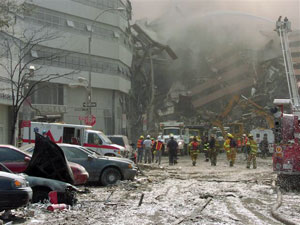
I pause for a moment while taking it all in. I find the command post again and approach Chief Haring, let him know I’m still working on some things and ask if there is anything else I can do to help. He states that he’s all right for the time being, just missing one more building. It occurs to me that he’s probably been standing there in the middle of the street with his aid and status board for hours. So I tell him that I’m going to set him up a command post. He looks at me quizzically and breaks out into a slight grin as I take off to the north. I work my way back to the flow of traffic coming in on West Street and corral two volunteer fire department pick-up trucks from New Jersey. Great guys and all too eager to help. We head back to my hotel at the Sheraton New York, proceed to “borrow” several tables and about two dozen chairs, along with a stack of pads and pens. This should aid the chief and his officers in keeping track of everything. The hotel staff kindly offers any resources we require. I take a few moments, dash upstairs to grab my camera, but forget my ID, which was dumb. It makes things much more difficult for me later, moving back and forth through the checkpoints until badges can be made.
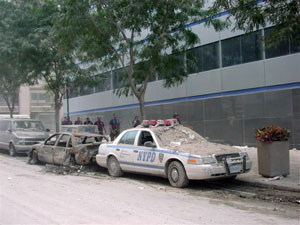
All I’m thinking about while in my room is getting that camera and trying to capture some of the devastation down at the site. The scene needs to be captured and pictures are worth a thousand words. Leaving, I pull the door shut, wishing I had the time to clean up and get some of this dust off me. As we load up the trucks it strikes me how quiet it is, even up here in midtown. The streets are mostly deserted, almost no cabs anywhere, which is unheard of in this town. Even the few people I notice walking down the street aren’t saying anything. The city has gotten the wind knocked out of it and it is quite noticeable. It seems all of Manhattan, a bustling metropolis, is now a virtual ghost town. It is so eerie. The silence is disturbing and unsettling at once. We race back to the site and set everything up. The volunteers were terrific and very much needed. The chief appreciates the effort, as he finally has a place to sit down and rest a bit while formulating his next round of orders. I also provide him a detailed weather report I got while at the front desk of the hotel. Things are all clear for now, as we agree it is vital that the weather stays calm and clear for as long as possible. I excuse myself and make a quick jaunt down a few streets on the northeast side of the site, camera in hand. I’ve got to snap off a few shots and at least record a small fraction of what things are like, before it gets dark. After taking about 30 haphazard shots, it’s time to get back to work. Now I need to try and find someone from the Port Authority to help me with that haz-mat report and maybe some blueprints. Off I go wandering again, not knowing where to go, where to start. I stop more people than I can count, asking if they know where anyone from the P.A. is. As I’m walking at a fast pace down West Street, I take note that it is now dusk and the light on this terrible day has passed. It is a long night. Sometime just before dawn, I decide to run back to the hotel and shower. It feels like my skin is crawling. I know that I absolutely have to take about 20 to 30 minutes and flush my eyes, as the burning is getting worse. I greatly value my eyesight. My throat is raw, feeling as if I swallowed a handful of dry straw.
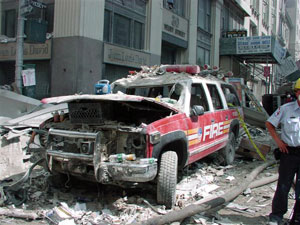
I walk for a very long way before catching a ride and head straight for the shower as soon as I walk in the door. The hotel security director later tells me I looked like Casper, The Friendly Ghost. I am covered head to toe with white dust and soot. Receiving some awfully strange stares in the lobby, I head up to my room to “decon.” I turn the facecloths, towels and tub a disgusting shade of dark brown while trying to clean this film off me. I don’t think I’ve ever been so filthy. Looking down at my chest and arms, I notice several areas where strange-looking red rashes have formed … probably from the irritants in the air, I’m thinking. Only I don’t remember scratching at all … anywhere. Strange. I remember standing there with my head resting against the shower wall, trying to sort out the day’s events and all that I had seen and felt. My mind decides it is better to just push everything to the rear and keep moving forward. It is simply too much to process right now. I step out onto the tile floor and the realization that I have no clothes, not even so much as a toothbrush. The scratching cough I’ve had all day is persistent. I’m not sure what to do first, gargle with mouthwash or begin flushing my eyes. I take care of my eyes first, then as I’m reaching for the Scope the hotel provides, I start coughing up bright red blood. I think nothing of it, quickly passing it off to throat irritation.
I must have consumed a package of Halls and used half a bottle of Visine a day while I was there. Visine is not very good as an eye flush, but when you’re running around like a chicken with its head cut-off, finding the time and opportunity to use running water just isn’t very feasible. So when I finish cleaning up at the hotel that first night, I ease back into the same nasty, contaminated clothes and head back down to the command post. I am only gone about two hours.
Day: 1 [2] 3 4 5 6 7 8 9 10 The Last Day
DAY TWO
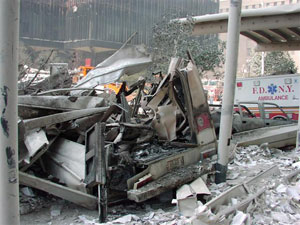
The sun rises on the second day and it is almost as hectic as the first. There is so much happening, with everyone working at a feverish pace. It has now been officially dubbed “Ground Zero” by the media. It seems fitting, since the term harkens to the origin of a nuclear detonation and this certainly looks like one. We all know, without saying a word that time is running out on anyone trapped in the rubble. The largest fires are being brought under control. The formation of multiple rescue teams continue to form, in order to probe in and around what becomes commonly known as “The Pile,” the large debris field where the twin towers once stood. The estimated number of civilians lost appears to be plummeting, now at around 5,000. Oddly though, the number of missing firefighters is rising, up to about 280 today. Now security around the site is getting much tighter. The National Guard has been brought in to establish a security perimeter. We are hearing reports of looting and even of one guy, who said he was with FEMA, who slid past police and went down to the site, stealing personal affects from bodies lying in the street the first day. Marvelous. We are also advised of a new threat — apparently three suicide bombers have made it past security on foot and are targeting the command post. Then the next day, we are told of a terrorist cell stealing a fire truck, loading it with explosives and driving it past a checkpoint, “so be on the look-out.” Thankfully, all these wild rumors are unfounded, but they still kept everyone on edge.

Not only are you in the midst of a major tragedy, now you’ve got the added pressure of worrying about another attack. Another one surfaces on day three or four about a truck filled with explosives that the state police intercepted trying to get across the George Washington Bridge into the city. Another false call, thankfully. Military helicopters constantly circle overhead, while jet fighters continue to patrol from a higher altitude. At least they won’t be attacking anymore from the air, I’m thinking. I spend the majority of the second day trying to track down any blueprints that can be found on the complex. No one seems to know where a surviving set might be and it becomes more frustrating. The crews probing the sub-levels are trying to search a site 16 acres in size, under extremely difficult conditions. Some can find no access to these areas due to stairwells blocked by debris. We could really use those prints about now. Right out of the blue, my phone rings. Cell phone service must be back up. It is a supervisor from the GSA (Government Services Administration), who was given my cell number by the IC. He tells me he has a near complete set of drawings on most of the complex, except for the twin towers and sub-level shopping concourse. Finally, something goes right! He gives me his location — the Federal Building, about ten blocks away from where I am. Asked if he can get them to the command post, I am told no, as he has no security clearance to the site. I tell him “Neither do I, technically,” but agree to come to him. He states that they are in “lockdown,” so he’ll meet me in the lobby and will escort me up to his floor. I tell him I’ll be there in 20 minutes. Working my way back through a checkpoint, I am challenged by a National Guardsman for ID. I tell him I have none with me, but have been at the site for two days and am working with the fire department. He then explains that I need a clearance badge. I’m directed to a nearby building where the police department has set up their command post.
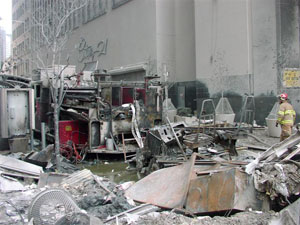
I go over there, only to find out that they haven’t started making any yet, so I am told to just use my driver’s license until they can get their ID process established. My license, of course, is back at the hotel in my briefcase (I don’t carry a wallet). So I go back to the checkpoint and advise the guard, who in turn, tells me I need an ID or cannot pass back through. Just as a spirited discussion breaks out, once again, someone comes to my rescue. A guy wearing an FBI jacket overhears the conversation about why I have to get to the Federal Building and steps in, whips out his badge and vouches for me. Instant credibility! The next thing you know, he becomes my escort and fast friend. For the rest of my time spent at the disaster, he gets me anywhere I need to go … or he feels I should go. I mean anywhere. The Federal Building, the Jacob Javits Center (temporary home to FEMA), Police and FBI command posts, OEM (Office of Emergency Management) HQ, the mayor and governor’s command posts, you name it. He quickly acquires me all the magical badges and IDs necessary to get around. His name is Mike [last name withheld for security reasons] and this guy is the real-life version of superman. He’ll probably never forgive me for saying this, but I’m not kidding. He is a liaison officer to the FBI on loan from the NYPD, a select group called “Joint Task Force on Terrorism.” He is also, in addition to being a detective, a paramedic and search & rescue expert — one of the best in the world. He is a member of both FEMA and NYTF1 (New York Task Force 1 — an elite squad of police and fire S&R specialists).
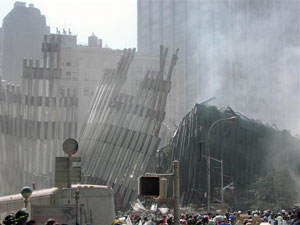
He has responded to, dealt with and investigated just about every major disaster affecting U.S. interests in the last 10 years. Everything from the two U.S. embassy bombings in Africa, to the U.S.S. Cole attack in Yemen, to the ‘93 WTC bombing, to the ‘95 Oklahoma City bombing, the recent Puerto Rico hurricane and now here he is, doing his thing again on his home turf. (He has since responded on and investigated all the Anthrax incidents in NY, as well as the Queens airplane crash late last year — … he was even the first officer to handle the Tom Brokaw letter!). Like I said, this man is unbelievable. He does it all and is extremely intelligent. Not the guy you want chasing you if you’re a terrorist. So my new pal, Mike, gets me over to the Federal Building, we review and choose which prints are useful to us and head back to the site. He takes me to the newly established NYTF1 tent on Chambers and introduces me to all the guys, including a man named Steve Spall. Steve is another search and rescue guru with the FDNY and knows Mike through the task force. You can tell quickly by the way he acts and speaks that he is an ace too, clearly “knowing his stuff.” Soon, we are advised that a few people have called 911 dispatch centers and reported themselves to be trapped in various places in the rubble. One woman claims she is trapped in a clothing store in the mall called “Strawberry,” another says she is in “Duane Reade” a pharmacy. They couldn’t offer any details as to where they were in relation to nearby streets, so we are left to our own means in determining their location. Considering the fact that the sub-grade mall is the largest shopping center in Manhattan, totaling 200 shops and restaurants, makes our task that much more difficult.
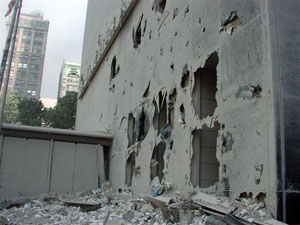
We break out the prints and start highlighting all the key features with magic markers, as we openly discuss how and where access can be made to the concourse. We find street level airshafts and subway station entrances surrounding “the pile” and banter on the feasibility of each as access points. Steve and Mike come up with some terrific ideas and we begin plotting a course of action to propose to the IC post. After we finish, we split up and go separate ways, determined that if there are people down there needing to be rescued, then it was going to happen. I head over to the far side of the site to scout secondary entry points, sketch some things, then make my way to the IC post. After the effort appears to be in full swing, I then focus my attention on putting together some important notes for the announced 10:00 briefing at the OEM command post, a converted elementary school at West and Chambers.
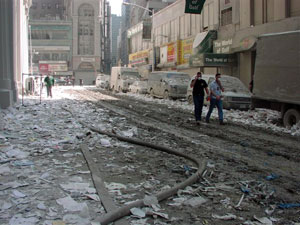
After arriving at the NYTF1 tent, I brush off the ever-present dust from a large trunk and plop down to begin compiling some key construction facts my office sent me on the twin towers, in addition to the haz-mat list I promised Chief Haring. Word spreads that a rescue was accomplished, further raising hope that there are still live victims in the rubble. Everyone picks it up another notch with renewed vigor. Non-stop effort. Several hours later, I gather my notes and walk over to the OEM post a half-block away. Bustling activity surrounds the school’s cafeteria, where the top level personnel from all the agencies involved with the initiative are gathering to discuss how this incident is going to be managed. I am introduced to Jeff Armstrong, the overall scene commander. Everyone, including the FD and PD, even the Feds, report to him. I end up working with Jeff quite a bit over the next week and a half and become highly impressed with his abilities and leadership skills. This is a guy who can handle pressure. Plus, he’s a really nice person, with his ego very much in check. Jeff states its time to start the meeting, grabs a bullhorn and brings the conversations to a halt. The session begins. There is electricity in the room. The latest report on the rescue effort is reviewed, along with the bad news — fatality and injury statistics. The din of multiple generators hum away, just outside in the courtyard. We are still without most essential services, but at least we have light and phones, thanks to the quick work of the phone company.
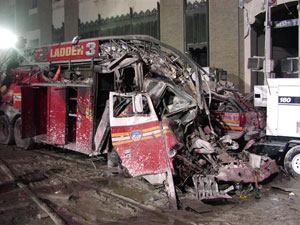
By now, cables lay in the street in every direction as far as the eye can see. We expect to have temporary power within the next few days. After the most critical issues have been addressed, Chief Fellini introduces me to the audience. I feel a bit uneasy taking center stage, fumbling with all my charts and stats, not really feeling like I fit in. During the briefing, I offer up how much construction material went into building the towers. This will give the superintendents of the debris removal an idea of what it will take to remove it from the collapse site. Over a million tons of steel, glass and concrete. I then propose what my estimate is of the types and quantities of haz-mat that were present before the collapse and what may be in the smoke, in the way of fire byproducts. It is not very reassuring. I stress again that this is a major hazardous materials event, although clearly stipulating that I am not a haz-mat expert. I explain that everyone working at the site may have been exposed to some serious chemicals and carcinogens. Decontamination will become an issue, as no one’s clothes can be deemed safe. I also bring up the topic of synergy. Puzzled faces stare back at me, wondering where I’m heading with this thought. I explain to the audience that when you have certain known hazardous materials with their associated properties and mix them together, totally new compounds can be formed, with their own given hazards that no one has any idea what they might be and their effects on humans.

I state that I am certain this has taken place, but as to the extent and related danger to us working the site, I am unsure. There is a look of great concern from most of the audience. The topic then changes to search and rescue. I display an illustration of the core area of the towers. My suggestion is that at least 80% of the victims, dead or alive, will be found in and around the areas where the stairwells and elevator shafts once stood. I figure the majority of the rescue workers and civilians had to be off the floors at the time of collapse and either moving up or down the stairs and elevators. They are now probably somewhere at and below grade level, as the towers go down six stories below the street. The core being better shelter than an open floor, offers us the best opportunity to come up with some “live hits.” I also offer the thought that the very highest probability of success for rescues will most likely be found in the sub-grade concourse level beneath the plaza, between the towers, specifically in the food court area. There has to be some void spaces down there.

There’s food and water present which should sustain life for at least several days. Victim dehydration is a big concern. If there is a fresh air source present, of course, there’s at least a chance. Although a grim task lies ahead, resources are precious and it is agreed they must be used wisely and effectively. Searches must be concentrated on the highest areas of potential survivability. My notes and drawings are done on large sheets of poster board with magic markers and held up for the audience by one of the team members. It is crude, but it succeeds in getting the main points across that I wished to focus on. Everyone seems to be clutching a bottle of spring water, as it is warm and everyone is working at a feverish pace. The faces staring back at me display tremendous determination and grit. People from all occupations and backgrounds, working together as one cohesive unit. A team. We have been attacked, yet no one is faltering. Jeff takes over again and the briefing concludes with the agreement we all meet back here in six hours. I head back over to the tent to see what the guys are up to. As I’m approaching the entrance, a police officer suddenly walks up to me and advises that they have just received a message that there are several fellow police officers reported to be alive, but trapped in the rubble. It was reported at the scene itself by a nurse in uniform. She stated that she talked to her husband, a police officer, and was told that he and several fellow officers were trapped at a specific location. This also was acted on, but she ends up being unstable and the report turns out to be a hoax. What a waste of time and resources! The question arises whether the other reports are legitimate, although they must be acted upon until proven false. The scene remains a flurry of activity. The pressure and adrenaline remain high.
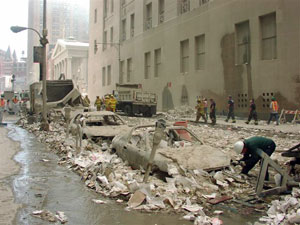
Everyone rushes back and forth, as there is so much to do. The sound of helicopters, construction equipment and portable generators fill the air, creating a certain tension all their own. The night wears on, seemingly endless. After traveling between the command post and the NYTF1 tent for hours, I feel fatigue beginning to overtake me. The last sleep I had was two days ago and as activity away from the site slowed down a bit approaching 3:00, you could feel the adrenaline beginning to subside. After a brief conversation with Chief Haring, who was still working like a machine, I walked back through the security check point to the dimly lit tent. The search crews who were there earlier had left to go down to the site. The two guys manning the tent were obviously exhausted and trying to catch a quick catnap. They too had been working long hours and it showed on them. It was relatively quiet, even the radio had minimal activity, so I plopped down in a chair to flush my eyes again. The constant burning was annoying. While I tilted my head, my eyes clamped shut, letting the cool liquid work its short-lived magic. The urge to rest was overwhelming, so I leaned forward and put my head in my hands, letting my thoughts wander, taking me back through the past two days. A single light bulb behind the desk began shorting, blinking off for a few moments, then back on again, repeating the process over and over while the generators hummed away outside the tent, in perfect cadence. One hour till the next briefing. No time to stop now, so back to work. I need to study those drawings some more. The night slowly turns into dawn and we have been blessed with excellent weather.
Day: 1 2 [3] 4 5 6 7 8 9 10 The Last Day
DAY THREE
A new day unfolds on this tragedy, yet another day of hope. Everyone seems upbeat that we will pull another victim from the rubble alive, yet we all realize time is running out. Spirits slip just a bit, when we are told the rescue made yesterday was of a rescue worker who had fallen into a void space. So nothing after day one. At the tent, now designated as Special Operations Command (SOC) HQ, I meet another search and rescue specialist from the FDNY, Bob Athanas. Terrific guy. Extremely talented and knowledgeable, just like Steve and Mike.
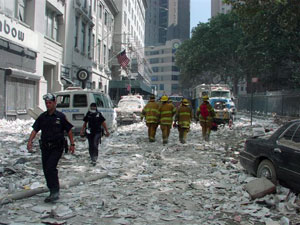
We talk about the effort and our rapidly diminishing chances of success. Still no live hits. The estimate for missing firefighters is now up to 300 and rising. Damn! Why is it going up?? Enough bad news already! Steve Spall walks in and joins the conversation. He enlightens us that at Kobe, Japan, a baby was rescued after 13 days in the remains of a building brought down by the earthquake. We agree to use that as our benchmark. As Steve leaves the tent heading back to “the pile,” he pauses and says, “We’ve gotta have a miracle here!” then strides on in silent confidence … and in defiance of it all. I envy him for his resilience … and his courage to believe in miracles. A volunteer steps in and hands out more water and sandwiches. Your choice again today, ham and cheese or cheese and ham. I go with the former and begin inhaling the first “meal” in 12 hours, washing it down with a bottle of water as I walk over to the OEM command post for another briefing on the event’s progress. Suddenly it occurs to me that I should make an effort to get back to the hotel for another shower, as the clothes I’ve been wearing for the third day are getting to me … and probably those around me. They’re as filthy as they were on day one. I’ve since managed to get through to my office and asked one of my guys to drive up to D.C., pick-up my bags and bring them up to New York. The airlines are still shut down. There is no word as to when they’ll start flying again. The New York Stock Exchange, another one of our clients, is still down for the count as well and the losses are mounting. After the briefing, I decide to head back to the hotel. I make my way through security and walk towards Canal Street. Knowing how hard it is going to be to get back to midtown, I begin dragging just a bit in my gait.
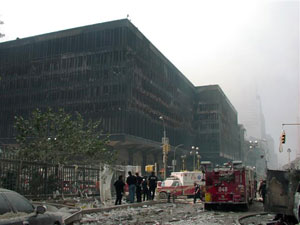
Then, I hear a fire truck coming down the street towards me, heading north as well. I step into the street and flag them down. They stop as I take note that the truck looks even worse than I do, covered in white, chalky dust. It is obvious this rig was close to the scene when the towers came down, yet other than being dirty, appears unscathed. The two guys up front agree to give me a lift. I open the door to the jumpseat and climb in, almost tripping over a pair of shoes lying there in front of me. As I pull the door shut and the rig eases into motion, I notice other personal gear around me and judging by the condition of everything, it is obvious that it does not belong to the men up front. It’s all covered in thick dust. Then it hits me while we’re riding down 6th Avenue that the guys that responded on this piece must not have survived … or they would have pulled their stuff off the rig by now, especially their shoes. Looking down at them, I remembered walking into the firehouse of two former colleagues of mine who were killed on the job and seeing their shoes still lying on the floor of the apparatus bay. The boys heading out on what appeared to be a B.S. call (“short in the panel box”) and never coming back, killed in a truss roof collapse within 15 minutes of leaving the station by a fire raging over their heads above two false ceilings.
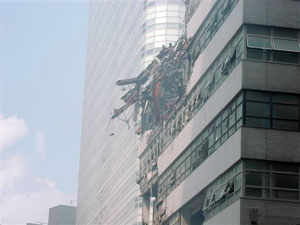
Here I am looking at those same shoes again, kicked-off before a final run. My heart sinks for these brave souls and their families. A truck probably returning from the crew’s last alarm. A strange feeling overtakes me as heavy, choking dust swirls through the cab with the wind, covering me with even more white powder. There is a slight sensation of riding in a “ghost” fire truck. As the engine winds its way through the streets, I stick my head out the side window for some clean air, watching the crowds on the sidewalks. Suddenly, one by one, they stop and begin cheering and clapping as we pass by. It grows like an ocean wave, throngs of people on both sides of the street yelling and cheering at us. The guys up front solemnly wave their thanks and I feel compelled to do so as well to acknowledge them. I feel incredibly awkward as I raise my hand in thanks too, because these people are cheering heroes and I am not one of them. The heroes are the guys up front … and the men who wore these shoes I am standing next to. Men who will not be seeing their loved ones ever again.
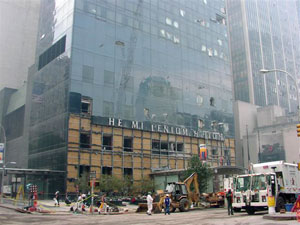
Men who laid down their lives doing what they do best, protecting the very same people who cheer us on from curbside. They are the heroes. A feeling of reverence washes over me and for the first time since I arrived, the emotion of the event starts to creep up on me. I quickly fight off the thoughts and focus on matters at hand. The crowd cheers us on, block after block, until the truck pulls over and lets me off on 52nd street. I dismount and thank the men for the lift. I feel compelled to ask them the status of the engine’s crew, but decide not to. It is too obvious, I think, and I don’t want to hear the answer. Too many good men are missing. These are probably just a few of many heroes. Maybe they survived and are at a local hospital, I hope … I quickly walk the next block to the hotel and am met in the lobby by Jimmy, the bellhop. Jimmy’s a great guy and he sees my state of attire. I am once again covered in dust, head to toe. He offers to give me a spare uniform. I quickly accept. They might be more dress clothes, but at least they’re clean. He brings a pair of black slacks and two white shirts up to my room, along with a pair of socks. I thank him profusely and head in the direction of a hot shower. My girlfriend at the time brings me some new boxer shorts and several bottles of Visine and Halls cough drops. She was terrific in supporting me through this ordeal, even though she knew she wouldn’t be seeing a lot of me during my stay.
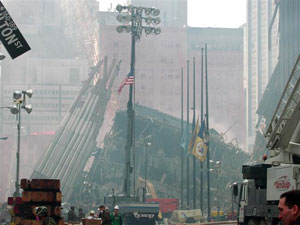
After getting out of the shower and putting on some fresh clothes, I actually begin feeling good about going back down to the site and helping to possibly get someone out alive before time runs out. I quickly switch on the TV to get an updated weather report and see for the first time the video of the planes striking the towers. I stand there awestruck, not really believing what I am seeing, yet knowing it is all too real. It did happen. The towers collapse before my eyes, captured on tape for a worldwide audience. A few moments in time that will replayed a thousand times over during the next few days. I watch it two or three times in a row before jumping back into work mode and switching over to the weather channel. Great, a storm is heading our way, with heavy rain and high winds tonight. I kill the TV and dart back out the door. The local police precinct once again rises to the occasion and gives me a quick lift in a patrol car down to the site. As we approach the scene on West Street, hundreds of people lining the street begin clapping and holding up signs saying “Thank You” and “We Support You,” offering us sandwiches and water as we slow up for the security checkpoint. This is also reminiscent of Frank and Johnnie’s funeral back in Chesapeake, with the outpouring of public sentiment and support in our time of need. Letting us all know that they appreciate our efforts and that our losses will not go unnoticed … and hopefully not forgotten.

It leaves me with a warm feeling inside as I make my way over to Chief Haring to give him the updated news on the weather. He’s still going strong. His kindly manner exudes confidence in those around him and he welcomes me with a warm smile. He fills me in on the latest and I head over to the SOC tent, as darkness slowly envelopes the site once again. I run into Mike, Bob and Steve, ideas swarming around in their heads, spilling out into their speech. Mike remembers a model of the Trade Center’s sub-level, made up for the ‘93 bombing trial. It’s been in storage in a New Jersey warehouse and he orders it brought to the tent. Soon, a truck pulls up and backs into the staging area. Meanwhile, the National Guard pitches in and rapidly builds a large table to set the model on. The sounds of saws and hammers fill the air. As we talk about the arrival and assignments of USAR teams from throughout the country descending into the city to help out, the scene’s activity continues at an energized pace. An hour later, the truck’s hydraulic lift gently lowers the finely crafted model down to the waiting arms of a dozen guardsmen, all under the watchful eye of Mike. The costly model is then transferred over to one of the tents and on to the newly constructed perch.
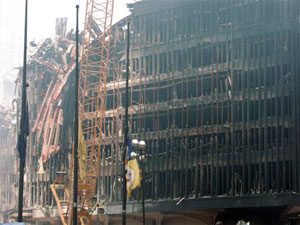
Everyone in the SOC and NYPD tents come over and gather around, staring intently at our new “3-dimensional blueprint.” Steve and Bob come up with some great suggestions on access problems, with Mike adding in an innovative idea based on expected conditions at these levels. The stability of the “slurry wall” is raised (the perimeter barrier wall encircling the base of the complex), since reports are coming in of major flooding on Level B-6, the lowest level. With river water apparently pouring in from compromised PATH tubes (mass transit trains to New Jersey), tension mounts as we discuss the effects of the water on the foundation walls. If the walls were to fail or even shift, it could destabilize “the pile” and greatly endanger the rescue workers operating above and just below street level. The issue is also raised as to the effect of all the heavy construction machinery moving around directly above the walls, as water pours into open spaces below. The danger to everyone working the site is high already from all the known hazards that have been recognized, now another one jumps to the surface of thoughts regarding safety … and the unknown. Adrenaline flows like electricity. Communication of this newly discovered danger is quickly relayed to the FD, PD and OEM command posts. Steve heads off for another probe into the sublevels, while Mike and I head down to walk around the site for an up-to-date visual assessment. Bob stays at the tent, formulating solutions to problems almost as fast as they can be raised. At the CP, Chief Richardson is right on top of things, conversing with various engineers about the water’s threat, as well as possible dewatering solutions. Just when you think things can’t get any more tense, the storm front moves in. The wind begins to whip up, with gusts exceeding 30 mph, stirring settled dust back into a maelstrom.
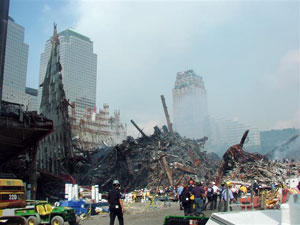
Chief Fellini expresses concern over broken window panes which dangle precariously from tall buildings surrounding all four sides of the site and the danger they present to the workers below. He had already assigned a contingent of men to clear glass from above, but there was a lot to do. The imminent suspension of activities until the storm passes force Mike and I to head back to the hotel for some much needed rest and food. After we make it back to midtown and the refuge of the lobby, the storm hits, unleashing a torrential downpour for several hours. Oddly enough, we are both too pumped to sleep, despite the overwhelming fatigue. Neither of us has slept since Monday night, three days ago. Instead of heading straight to bed, we hang out in the lobby restaurant, talking, staring in disbelief as TV monitors surrounding us portray the attacks over and over, from every conceivable angle. Our senses are continually bombarded by the absolute madness of it all, hammering us to the point where you don’t want to look anymore, yet your eyes unconsciously turn back to the screen with every clip shown. Finally around 2:00, we decide to call it a day and part ways until the morning, each looking forward to a hot shower and a few unsettling Zs, as the rain comes down in gusty torrents outside. We agree to meet in the lobby at 7:00.
Day: 1 2 3 [4] 5 6 7 8 9 10 The Last Day
DAY FOUR
With the rain passing while we slept, Mike and I greet one another in the lobby, already looking forward to getting down to the site. It is sunny again, in the 70s. We eat a quick breakfast and then back to work. After arriving, we are met with muddy streets and sidewalks where ash, dust and debris once sat, a foot thick in places. I’m still walking around in dress clothes, looking like a waiter and feeling very awkward all the while. Midway through a busy morning, I receive a cell phone call that my bags have finally caught up with me, due to the efforts of one of my employees. I had asked that Jim also bring with him 30 small 8½” x 11″ booklets containing all the site plans, USAR grids and “fire department summary sheets” for all the surrounding buildings we have pre-planned. Labeled “F.D. Data,” these booklets contain valuable information and are quickly distributed to the OEM, F.D. and P.D. command posts, in addition to all the FEMA teams. As a back-up, Jim includes in his package extra complete pre-plans for the Empire State Building and the New York Stock Exchange, in the event they are targeted as well.

I keep these at the hotel, in case they are needed. After our morning talk with Steve, Bob and the guys at the SOC tent, I head out on my never-ending quest to locate the remaining blueprints we so desperately need, specifically for the twin towers’ sub-levels and concourse area. As I’m leaving the tent, I am met with an entourage of federal agents who ask for me by name. I just know I’ve done something wrong and feel a sudden compulsion to place my hands behind my back to be handcuffed, or run like mad. It must be a guilt complex from my troublesome childhood. They immediately ease my concerns by stating that they have been assigned to me to provide any and all assistance I might require in carrying out the tasks I’ve set out to accomplish. They are from the State Department and look like a real serious group of people. After some brief introductions, they let me know they have several vehicles staged and ready to take me anywhere. These are the same folks who provide transportation and added security for the President and other dignitaries when they visit the city. They are all wearing dark blue windbreakers with “State Department” emblazoned across the back in bold yellow letters and yes, they carry big guns too! For the next six days, they prove to be an invaluable resource, taking me anywhere I need to go. These folks are very, very good at what they do. They are highly professional, yet friendly and, as it turns out, great to work with in every way. One of them even jokes me about my “waiter look” and asks if I am going to be dressed like this the whole time we are working together. About this time, Mike comes to my rescue again, as he strolls up and hands me three NYTF1 t-shirts and suggests I put one on.
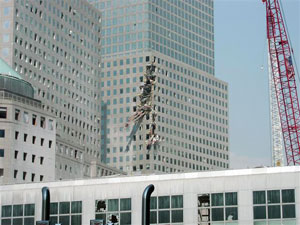
He says it will help me in getting around the site and through security. My dress attire must be getting to everyone. Since I can’t take it anymore either and with my clothes finally having arrived, I ask the agents for a lift back to my hotel. We are off on our first “assignment” together, in one of those big black Suburbans with the tinted windows. After quickly changing into some comfortable, casual duds and new t-shirt, I carefully double-bag all my clothes from day one, shoes included and hand them to the maid in the hallway to be disposed of, along with a ten-spot. As contaminated as they are, I don’t ever want to wear them again and most certainly would not put them in my washing machine. Out the door and over to the Javits Center. The whole place has been transformed into one giant “holding pen” for all the FEMA teams. I hook back up with Mike and we walk over to speak with Fred Endrikat, the FEMA honcho and Lieutenant of Philadelphia’s Rescue 1. Fred and I already know one another peripherally, but it is good to see him again and very good to see him here in New York. He is one of the best in the business in Urban Search and Rescue and is a guy you want on “the big one.” His easy-going demeanor belies his commanding presence and strong spirit. With guys like him, Mike, Steve Spall and Bob Athanas, I know the people that might still be alive below grade are in the best hands possible. Their chances of survival couldn’t be higher with any other group of individuals. They are disaster specialists and are as talented as they come. Unfortunately, the number of missing firefighters is now up to 320. I express my disappointment to Freddy that we still have not located all the needed blueprints to aid the cause, especially the important ones. Typical of him and in that low-key voice of his, calmly says, “Curtis, don’t worry, the drawings will show up. We’re going to get through this whole ordeal OK. We can’t let them win and we can’t lose any more men than we already have, so let’s be sure we do this thing by the book. Everyone needs to focus on safety.” After finishing our conversation, I walk over to the planning area with Mike, thinking how fortunate we are to have a man like Freddy here. The FEMA architectural & engineering guys show us a hot-off-the-press aerial photo of the scene on poster-sized paper.
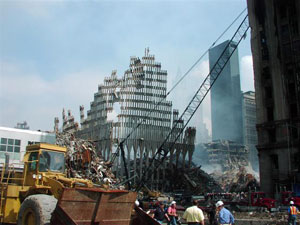
It is quite a sight, seeing for the first time a bird’s eye view of the devastation. It almost takes your breath away. There they are, clear as day, the walls of the towers laid out across the street in several different directions away from the site, some in 20 – 30 story chunks, still connected. For days I’ve walked right over some of these sections amidst debris and didn’t even know it. You knew from pieces of the walls being imbedded in the sides of nearby buildings that it had not “pancaked” all the way down as the news footage led you to believe. Here is the final confirmation. We can now finally view the “big picture.” It is an amazing thing to see. They quickly roll an extra copy up for us to bring down to the CP. Mike and I are off again, heading in different directions, promising to meet at the tent around dark. The agents whisk me back down to the site, going around heavy traffic on the West Side Highway. As we approach the first of several checkpoints, we all notice the crowds of people lining both sides of the street, signs waving, clapping and cheering as we pass by. The driver taps the siren in “thanks” and we continue on our way. Everyone feels good about having so much support from the public and it goes a long way in keeping morale up, believe me. Bob and the guys at the SOC tent ride me about my new NYTF1 t-shirt and how I’m “not qualified to be one of them.” That’s ok though, I can take the abuse. Our activities push the minutes into hours and the day quickly draws to a close. Mike doesn’t make it back to the tent until late, as he’s handling 20 assignments simultaneously. He walks up to me around midnight and with exhaustion on his face says, “I’ve got a few things left to do, then let’s head back to the hotel and get some rest.” This is a guy who pushed himself so hard at Oklahoma City he passed out in the shower, splitting his head open in the process.
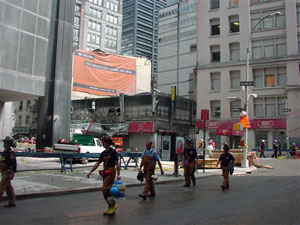
You can’t help but wonder if the general population even knows people like Mike exist … always putting duty before himself and probably his family. After conversing with Jeff (the OEM IC) and Chief Richardson one last time, I make my way back to the tent, dragging a bit. Mike strolls in right on cue. After wrapping up a few last details, we leave the scene for the hotel. It is around 1:00 AM and we talk about getting something to eat, our first meal since this morning. Midtown slowly seems to be coming back to life, albeit in a somewhat muted form. We meet in the lobby restaurant after getting cleaned up to wolf down a quick sandwich and a cold Coke, before calling it a day. We discuss the frustration of not getting any live hits again today and it bothers both of us. Across the room, a small party is gathered at the bar, apparently ignorant of the tragedy still unfolding only a few miles away. With intermittent pictures and video of the disaster showing on all the TV screens around them and fresh in the minds of all who were touched by the event, the group carries on as if they don’t have a care in the world. One of them, a very large woman, laughs with a loud, thunderous and might I add, abrasive cackle that cuts right through me. A cigarette dangles precariously from her unsteady fingers. The other hand clutches a drink. You almost feel compelled to walk over and slap every one of them silly. It is obvious they don’t know anyone who was killed or are missing in the attacks and are completely unfazed by the tragedy of it all. Their display of callous indifference and total lack of respect for what has happened disgusts me. Mike and I decide to get up and leave after being unable to tolerate their behavior any longer. It is easily noticeable that the other patrons around them are as peeved as we are, including the bartender, judging by the look on his face. They are oblivious to it all, or simply just don’t give a damn. Passing by the boisterous group, I whisper to Mike, asking if I can borrow his firearm for a second. He glances back at me with a concerned look, not knowing whether I’m kidding or not with my request. We shake hands in the elevator lobby and agree to meet at 6:30. Mike says we need to get down there a bit early, as the President is coming to town.
Day: 1 2 3 4 [5] 6 7 8 9 10 The Last Day
DAY FIVE
We hit the ground running. This Saturday morning begins as a rainy, dreary day. Mike and I talk about how lucky we had been with the weather overall and wonder how difficult things would be if it were raining every day. We are fortunate indeed, at least in this respect.
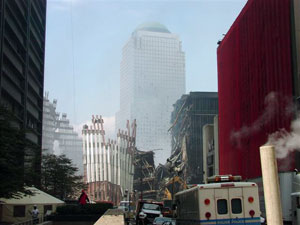
Mike runs us by the Javits Center, then by the FBI HQ, before heading on down to the site. We arrive just ahead of President Bush. His motorcade slowly ambles by the tent. We are so busy, it is hardly noticed. The entire scene is shut down tight and nobody moves in or out through the checkpoints. It would have been great to hear what he has to say to the troops, but there is just too much to do. We are planning a thorough, top-to-bottom search of a nearby 53-story building across from the site and will be joined by two out-of-state USAR teams, with search dogs. The missing firefighter count rises again for the fourth straight day. So many personnel responded who were off-duty, they could not immediately be accounted for. It is now at a firm head count of 343, almost a full one hundred above the original estimate. You can’t help but let it get to you. I am stunned at the count. It is equivalent to the size of the entire fire department I used to work for. Yet, every time it started to bother me, Steve would be there, picking me up, always being positive. He kept saying “There’s gotta be a miracle here” each time. You, in turn, had to believe that there would be. Mike heads over to the NYPD post and agrees to meet me in the lobby of One Liberty Plaza at 11:00. I turn my attention back to the issue of tracking down those missing prints, as the President’s motorcade passes by once again. The scene opens back up and activity returns to its previous pace. Time escapes me, as does the morning. Before I know it, 11:00 arrives. I dash over to the building, figuring to be late and instead walk into an empty lobby, not another soul in sight. It is strangely silent. I’ve been in this building so many times. I glance down at my watch. It is 11:10. Just as I’m beginning to question if the other guys went to the wrong building, Mike strolls in the front entrance, steady talking away on his cell phone.

Typical, he’s dealing with a dozen other things at the same time. As he finishes up his conversation, I whip out the building’s pre-fire plan and start breaking it down for the team leaders. Within five minutes, the lobby comes alive, filled with two police search teams and two USAR teams. We all gather around and discuss the operation. Since this property is one of my clients, I proudly show off the plan. Everyone is briefed on the stairwell configurations, roof and sub-level access issues, locations of haz-mat, etc. I then hand out sets of floor plans to each team leader, as there is still no power available for the darkened high-rise. I state, with Mike’s concurrence, that the building almost certainly has to have been searched at least once by now, (although it could not be confirmed) and that it would be wise to leave the dogs in the lobby unless they’re needed. This is a tall and very large building (2 million square feet) and the poor dogs are already exhausted from numerous searches. Suddenly, the chief engineer walks in and tells us that he can get the generator going, giving us basic life safety stuff and one elevator anyway. Having broken down the search patterns to “low” and “high” zone teams, eliminating the long climb to the top for the “high” team is greatly appreciated. Mike and I stay in the lobby, as a command post. The search begins. Mike is on the radio to another USAR search effort on the other side of the site, at the World Financial Center. As he is advising them that our pre-plans are in place for their use over there as well, I wander over to Brooks Brothers, a high-end clothing store on the west side of the first floor and look around. The place is a mess, several windows missing, countless suits ruined, everything coated with dust from the collapse across the street. After taking care of another call, Mike sticks his head in and advises me that the store was used as a temporary morgue on September 11, one of several in the area. Numerous people who jumped or were killed in the street by falling debris or even bodies from above, were brought in here.
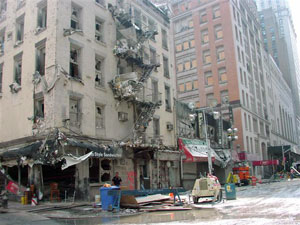
Standing there, now alone with just my thoughts, I wonder what it must have been like in here that tumultuous day. It had an unearthly feel to it. Dark, dusty and so quiet, you could hear a pin drop. It felt like death. I turned and walked out, not wanting to ponder anymore the horror that took place just four days ago in this once thriving enterprise. Just as I made it back into the lobby, the radios crackle “Evacuate!! Evacuate!!” Within seconds, guys are pouring into the lobby and out the front doors. I run up to Mike to try and determine what’s happening, when he says “Let’s go!” We both make a dash for the exit, along with everyone else, as thoughts are racing through my mind, “Is a nearby building getting ready to fall on us?” “Have they found a bomb?” “Are we under attack again?” I didn’t know I could run this fast, yet barely keeping up with the other guys. Thoughts of the last building collapsing Tuesday, still fresh in my memory, puts me a bit on edge. Once we reached the street corner and slowed down to a trot, I turned to the guys and asked what was up with the urgent order to evacuate. I’m told that the building is coming down. I immediately state aloud that the building is perfectly sound and can’t be collapsing. I’ve looked the property over several times from day one and it was evident to me that other than missing a bunch of windows, the structural integrity was unquestionably secure. After quickly convincing everyone that we were in no danger, we restarted our heart rhythms and returned to the lobby to complete our assignment. It turns out that a police officer heard a creak and felt a shift on the floor he was searching, so he ordered the evacuation.
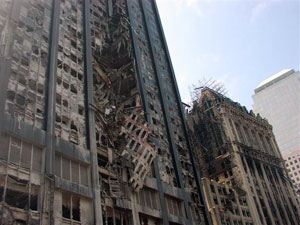
I could understand his concern. Having been in the building many times, it does, indeed, move slightly in a stiff wind. It is designed to do so and it does even creak noticeably, but it is as solid as a rock structurally. We soon complete the search, only to find out by a call to Larry (the owner rep.) that it had been searched previously by the FDNY and National Guard. All the effort and stress for nothing. Oh well, a little excitement to add to the day I suppose. I spend a few minutes petting the dogs before leaving with Mike to go back to the tent. I’ve never fully realized how valuable these animals are until now. They certainly have my heartfelt appreciation for their talent and hard work from this point on. They are just as courageous as the rescue workers. Mike discusses with me his ideas on the scene’s progress. The constant ballet of debris removal and construction equipment activity continues all around us. We pick-up where we left off with the guys at the SOC tent, being told that despite several more probes into the pile below grade, there have still been no live hits. Before we know it, the day concludes with the last meeting of the night at the OEM post, reviewing the latest accomplishments of all the agencies involved. It is 2:00 AM and we leave the site for the hotel.
Day: 1 2 3 4 5 [6] 7 8 9 10 The Last Day
DAY SIX
A bright, clear Sunday starts off with Mike and I arriving at the tent about 8:00. We are updated about the search teams’ findings from the night before. A subway train is still unaccounted for. We wonder aloud whether the occupants made it out alive, but the search continues nonetheless. The missing firefighter count remains the same as yesterday, finally stopping its ascent. Mid-morning, my cell phone rings. It is a Port Authority employee and he has something for me … a full set of blueprints for the twin towers’ sublevels! Finally!! I ask where he is at, write down the exact address, tell him not to move and that federal agents are on the way to pick them up. I dash outside the tent and over to the agents. I give the address in New Jersey, with precise directions and they’re off. I advise the FD and OEM CPs that the drawings have been located and will be at the site soon. In less than 45 minutes they return, prints in hand. We rush them into the tent and break them out on a table.
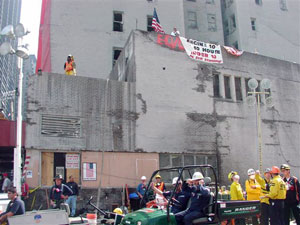
As they are unrolled, it becomes evident that they will be too complex and difficult to read for them to be of much use to the crews venturing below grade. We try to extract at least some critical data, but it is obvious more will need to be done. An idea pops into my mind and I step out of the tent. Pulling out my phone, I call my vice president at his home back in Virginia and tell him I need some people up here right away. Within an hour, three are on the way. Two are ex-fighter pilots and know how to work under pressure. By the end of the day, Jay, Bob and Chris are in the city and arrive at the hotel, software in hand. I advise the OEM IC we will need office space and computers. Shortly after my request, my phone rings again. It is the owner of a local architectural firm, offering us use of their facilities first thing tomorrow morning. Finally, things are starting to come together. As I’m walking down to West Street, a man approaches me at the check point. He’s a civilian, claiming that he has the most high-tech camera and listening device equipment in the world. He says he works for a defense contractor and has been stuck two blocks away with his gear for two days, unable to get through to the right people. Not at all surprised, given the scope of the disaster (and countless bogus claims from other folks), I escort him through the checkpoint and over to the ID area. After getting his credentials taken care of, we walk over to the tent and I introduce him to the guys. They advise the IC of this latest resource and he is put to work, along with his “toys” right away. Night closes in. Before I realize it, midnight passes. It’s back to the hotel for some rest. I check-in with my people and we agree to meet in the lobby, bright and early. I finally crawl into bed around 3:00 after making notes of ideas coming to mind and fall into another restless sleep.
Day: 1 2 3 4 5 6 [7] 8 9 10 The Last Day
DAY SEVEN
At 7:00, Mike, Bob, Chris, Jay and I greet each other. Introductions are made and Mike is off to a meeting.
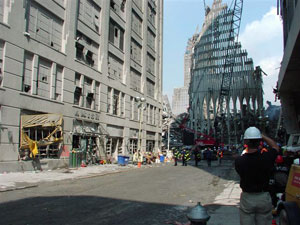
The agents arrive to take me to the site and my people to their new “home away from home” for the next few days, drawings in hand. They jump right into the fray and start pumping out floor plans in rapid fashion. They work in a building only a few blocks away from the scene, with windows overlooking the site on the 41st floor. They can’t believe what they see…or don’t see…anymore. Like the acidic haze which fills the air in lower Manhattan, the sight continually attacks the senses. The color-coded graphics take around four hours to do per floor. They are combination floor plans and USAR grids, displaying all the support columns on each level. They are completed two at a time, a matching floor of each tower. They are assigned eight floor plans to do, the Plaza and Concourse Levels and all sub-grade floors, B1 through B6. When the call comes, the agents rush me over to pick them up and it’s off to a printer in midtown, where 50 copies of each are duplicated in color. Several sets are then dropped off at the Javits Center for the USAR teams, with the rest brought back downtown for the fire, police, OEM and SOC CPs. Three floors are produced the first day. They call it a night 14 hours after they began and make it back to the hotel on their own. Mike and I stay at the site late again, finishing up around 2:00.
Day: 1 2 3 4 5 6 7 [8] 9 10 The Last Day
DAY EIGHT
The weather continues to hold and things go just as they did the day before. Running around, floor plans getting pumped out, everyone doing their thing and working hard. Still no rescues or signs of life. Admittedly, it starts to wear on me. I can feel my energy level draining away. The adrenaline is beginning to fade, as common sense is telling me we are clearly edging into a recovery operation. Other than three more floors being completed by my people, I remember very little of this day.
Day: 1 2 3 4 5 6 7 8 [9] 10 The Last Day
DAY NINE
Another busy day and the last two floor plans are completed. The agents once again are instrumental in getting them to all the CPs.

Walking around down at the site, I am astonished that there has been no fatalities since the first day. A constantly high-level of activity has encompassed the area. Monstrous cranes and heavy earthmoving equipment backing up, pulling away debris from the remains of buildings, along with lighter grade machinery dashing back and forth should have dictated at least a few serious mishaps. However, good fortune abounds, along with a lot of attention to safety by everyone involved. With fatigue beginning to take its toll, it is surprising no lives have been lost, especially considering the additional risk of unstable window panes and even steel structural members hanging off the facades of surrounding buildings. The ironworkers that walked up to the site and volunteered their expertise, along with all the other skilled laborers that came from the first day on, have proven to be as invaluable as anyone there. They are risking their lives along with everyone else, in performing highly dangerous work. Their collective contribution has not gone unnoticed and are an inspiration to us all.
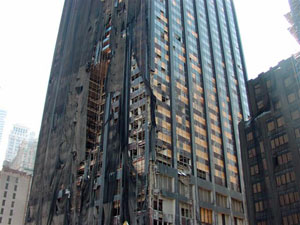
Coming back up West Street, I pass another contingent of FDNY firefighters returning from a 12 hour shift on “the pile.” Fatigue is written all over their faces. Victims are periodically uncovered and removed from the site. The remains of an entire engine company have been found in one area of where a stairwell once stood and I hear the chief calling for multiple body bags over their radio as they walk by. I feel for them and what they must be going through. I am both honored and humbled to even be in the presence of men of this caliber. Averaging around four hours of sleep per night, I am also running out of gas. My mind is slipping a bit. Throughout the day, I keep forgetting things, making simple, stupid mistakes. I recall standing on the street in front of the hotel that night, phone in hand, trying to call my parents to let them know I’m still OK. I’m amazed, as I can’t remember their phone number. They’ve had the same number for over 30 years and I’m drawing a complete blank.
Day: 1 2 3 4 5 6 7 8 9 [10] The Last Day
DAY TEN
I rise to face my last day of work at the site. The remaining two floor plans will be completed today. My people will be going back to their homes and anxiously awaiting families.
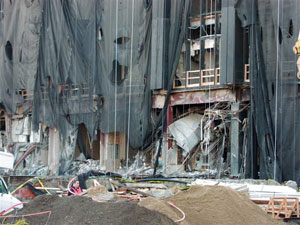
I spend the day tying up all my loose ends and strangely, still trying to find something else I can do. Yet, there is nothing left for me to do here. It is time to “pack it in” and head home as well tomorrow. Hope is clearly diminishing and admittedly, I am getting a little depressed. The adrenaline is now gone. Harsh reality has taken over. Even though it hasn’t been spoken, we have eased from a rescue into a recovery operation, although it is still officially labeled a “rescue effort.” I am exhausted and must get back to my job and the responsibilities that go with owning a business. The cost of spending almost two full business weeks here helping out has been substantial. Although I feel like I am letting the guys down a bit I worked with so closely during these most trying of times, life must go on. If I thought there might be a rescue still to be made, I would stay. However, logic dictates otherwise. I go by to drop off some things at the police CP and stop in the lobby of the converted school across from the OEM CP. My eyes are drawn to the many cards that cover the walls, sent from children in New York and beyond. I’ve passed by these things a hundred times these past few days, too busy to stop and look at any of them. This time I spend several minutes reading at least 20. I am touched by the heartfelt thanks and appreciation these kids have offered to all the rescue workers. Some of them are happy ones, some sad, some alarmingly graphic in an innocent kind of way. I am appalled at several scenes depicted in the cards — people diving out windows with their hair on fire as smoke billows from the top of the towers, some with victims being removed from the scene on stretchers, badly wounded and bleeding. I know that they didn’t see any of this stuff, yet they still are perceptive enough to realize it did happen.
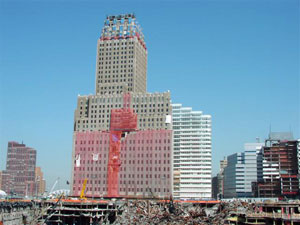
I suppose they are just trying to let the workers know that they are aware of the depth of the tragedy and are simply expressing themselves in their own way on paper. It is quite evident that this event has touched the entire population, coast to coast, both young and old. It is also clear that this country … especially its youth … has lost its innocence … and its sense of security. Patriotism abounds though and is displayed on poster after poster adorning these walls. A renewed pride seems to be taking hold in Americans. This, at least, is a good thing. My phone rings. It is word that the last floor plan of each tower is done, B-6, now flooded with water. I call the agents, ask for one final run to the building where my people are working next door to the New York Stock Exchange and I head back to the tent. We pick Bob, Chris and Jay up and head to midtown. We drop them off at the hotel where they gather their bags and head home. They were there when their country needed them, but now their job is done. After making my last stop at the Javits Center, we head back downtown. Working late into the evening wrapping things up, I finally recognize that I cannot offer anything more to the cause and must too go home.
Day: 1 2 3 4 5 6 7 8 9 10 [The Last Day]
THE LAST DAY Getting up early to allow plenty of time to pack, I survey the place I have resided these past 10 days. It feels odd now that I am leaving this hotel room…and this city behind.
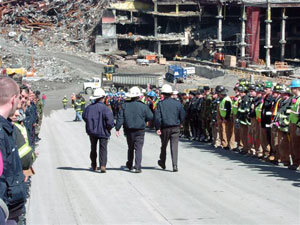
I gather my belongings for my early afternoon flight and head back down to the site for the final time. I can’t leave without saying farewell to everyone I’ve worked with and befriended during these days here. The strong, thick haze from ground zero still permeates the air. I decide to take a last walk all the way around the scene, to “take it all in” one final time, knowing I will never come back here again until it is rebuilt (and I haven’t, despite many offers). We all died a little on that day and our lives will be forever reshaped by those events. It was a catastrophe of near biblical comparisons. September 11 was certainly the darkest day in the FDNY’s history. Yet within that sad and tragic day, there could be found their finest moments. I make my way around the entire site one last time, snapping off another set of photos. I know I’ll be giving speeches on this down the road, so I’d better document as much as possible before I leave. It astonishes me that seven buildings have been destroyed or damaged beyond repair. 300 floors and 15 million square feet decimated, with another 15 million square feet in surrounding exposures damaged and off-line indefinitely. It’s still hard to believe it.
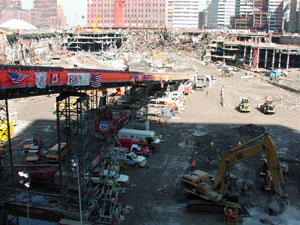
Suddenly, I see a familiar face coming toward me. It is Chief Pete Hayden and he is alive. This is one great person and I greet him warmly. He appears to be holding up just fine. Judging by the looks of him, I figured he must have been off Sept. 11, but instead find out that he was in the lobby of the north tower commanding his troops when the south tower collapsed. He narrowly averted death that day. The department could not afford to lose this guy. They lost too many good men as it is. He is obviously busy, so we part and I head on to the tent.
I find myself lost for words. Saying goodbye to everyone I worked with this past week and a half is not easy. I have to admit I was getting used to seeing the same friendly faces every day and felt blessed by the experience of being able to work side by side with such talented individuals — Mike, Steve Spall, Bob Athanas, Jeff Armstrong, the guys in the tent. Chiefs Fellini, Flaring, Richardson, Galvin, Corcoran, Ingram and too many others to mention. I will miss them. It felt good to be a part of their team. I only hoped I had contributed enough to make a difference, even a slight one. Friendships were molded that day and a bond was created that nothing can ever break. We were a part of history.
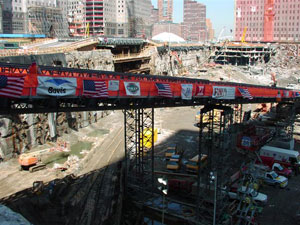
Finishing my farewells, I find myself standing on the corner of West and Liberty, out of film and out of energy, staring one last time at the still-smoldering ruins of what once was the World Trade Center.
My mind wanders from the sight in front of me to a Civil War battlefield my father took me to when I was a child. It was the first of many, many visits over the years to the outskirts of this small town in southern Pennsylvania, just across the border from Maryland. A military campaign took place here that changed the tide of the war in favor of the Union. It was the bloodiest battle ever to take place on American soil. About one-third of the total force of 160,000 men committed to battle on both sides were listed as casualties (dead, injured or missing) in only three days of fighting.
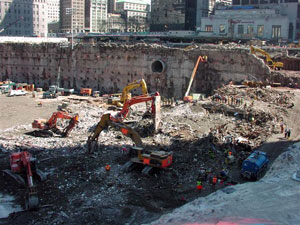
The town is Gettysburg. Many comparisons have been made to this epic battle since Sept. 11, mainly due to the sacrifices and bravery exhibited here on those first few days of July 1863. My father, a proud, career military man whom I admire so much, walked with me around the battlefield on that mid-summer day. He shared with me what occurred here and that our country’s history lay before me. Being only about 8 years old, I had difficulty comprehending the gravity of it all. The most pivotal part of the confrontation took place in a wheat field where 15,000 incredibly daring soldiers marched in formation, then charged fortified Union positions across a mile of mostly open space. It was later referred to as “Pickett’s Charge.” Vastly outgunned and outnumbered, their lines were decimated. Over 7,000 men failed to return from the assault. A few actually made it all the way to the Union position, most of them being killed or captured; some were even helped across the fortifications by their enemy, awed by the courage they had just displayed. It symbolized not only the peak of the South’s advance into Union lines, but the battle as well and eventually the war itself.
That is where I stood with my father, gazing out over the mostly unchanged landscape, trying to fathom the magnitude of what had unfolded at this spot, barely a century earlier. Watching the wind sweep across the tall grass toward me, originating from the wood line way in the distance where the charge began, I felt a sudden stirring of my soul. This, I thought, is where bravery and sacrifice for a given cause pushes men beyond the limits of human endurance, to perform superhuman feats that common men cannot imagine.
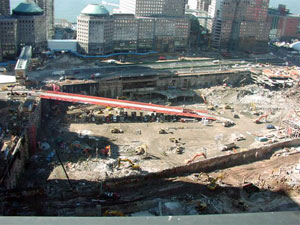
As a balmy breeze arrived, I felt a cold chill rush through me, penetrating me to the bone. The wind was hot, though. So what was it that I felt that day, as my father rested his hand on my shoulder, gently explaining to me the core value of what it means to make the ultimate sacrifice in performing something you believe in? I struggled to gain a true understanding of what my father meant, yet I knew something of great significance had taken place here on this sacred soil, this hallowed ground. I was touched by the experience and knew I would never forget it.
So here I am, standing tall on this warm autumn day gazing upon the ruins of where two awe-inspiring buildings once stood so high. Now I clearly understand, I am thinking, what courage and unselfish acts of heroism are really all about. The rush of men up into the towers, facing the unknown and possible death, was our modern version of “Pickett’s Charge.” Without hesitation, they disappeared into those stairs that would later serve as their tomb, to lead total strangers out of harm’s way, leaving their hopes and dreams, their families and friends, their very futures behind. They rose to the occasion in the heat of battle and performed with a gallantry and bravery few have ever known. A brief moment in time which defines us and who we are as a nation and where we stand as a human race.
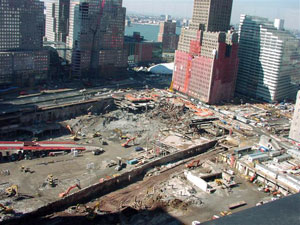
Now I know what the term “ultimate sacrifice” truly means. A staggering loss of almost 400 rescuers, 343 of them firefighters. My God, what a toll! This, I believe, is also hallowed ground. It is time to come home, brothers. Your job is done. You have saved thousands and I cry out from within for the loss of every one of you. You have redefined what it means to be a hero. You have taught us all so much without speaking a word. I respect you and I mourn for you. I feel that same distantly familiar feeling once again, something I haven’t felt since I was a child, a chill, a stirring of the soul.
Knowing none of us who were here will ever be as we once were, I turn to walk away before suppressed emotions rise to the surface. Pausing, I glance one last time at a place where so many are now gone and think, so this also is where heroes come to rest. The towers are no more.